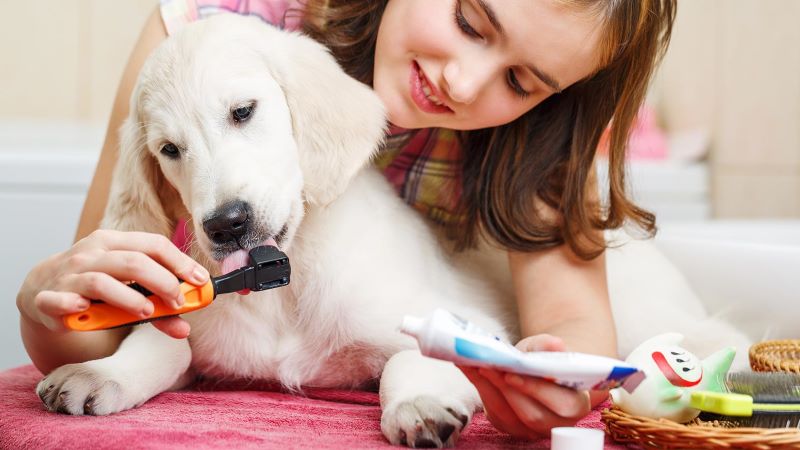Pet Dental Health Month is February! It's a good time to brush up--pun intended--on ways to keep your pet’s teeth clean. If you stick to a strict schedule of regular dental cleanings in your vet’s office, and brush a few times a week at home, you can avoid stinky breath and oral disease in your fur children.
Why brush your dog's teeth?
By age 3, most dogs are already showing signs of gum disease, which can lead to loose and diseased teeth, and even kidney, liver, and heart problems. Routine dental care can prevent periodontal disease. Prevention is key, especially since our pets cannot tell us when their mouths hurts. Dr. Tony Woodward, a veterinary dentist in Colorado says most dogs continue to act and eat just fine even when they have a mouthful of abscessed teeth.
Guidelines for dental cleaning
According to the American Veterinary Dental College, daily toothbrushing is the official recommendation. But, if you’re like me, getting my three human children to brush their teeth daily is enough of a chore! So, I was glad to hear that Veterinarian Gayle O’Konski says brushing biweekly can be enough to reduce tartar and plaque, when combined with regular vet cleanings. Here are some guidelines for your at home brushing...
- Use a toothpaste formulated for dogs, such as Petsmile Professional Pet Toothpaste. Using your own toothpaste can be harmful to dogs as it may contain fluoride and/or xylitol, which are toxic to dogs.
- Brush back and forth or in a circular motion for at least a minute on each side of the mouth and front. As with your own teeth, make sure to clean well where the teeth meet the gums, but do not brush so vigorously that you irritate the gum line.
- Slip the toothbrush or finger brush in between your dog’s lips and teeth. Nancy Kay, DVM warns you may get into a wrestling match if you try to pry your dog’s mouth open.
Helpful dental products for dogs
- Dental chews (such as Greenies Original Dental Chews) given three times a week. These are best if your dog spends a few minutes actually chewing them (and not wolfing them down) in order for the chewing action to aid in removing plaque.
- Fresh n’ floss 3 knot tug--removes plaque as your pet plays.. One reviewer said her dog’s rope toy has held up for several months and her vet says her dog’s teeth look perfect.
- C.E.T. Enzymatic Oral Hygiene Chews--A study in the Journal of Veterinary Dentistry, December, 1996, reported "The daily addition of a dental hygiene chew to a regimen of tooth brushing every other day reduced the gingivitis scores and reduced the accumulation of dental deposits.”
How often should I have my dog's teeth professionally cleaned?
Dr. Kay also stresses the importance of pro cleanings. How often your dog needs these cleanings is dependent on his teeth and how they are set. PetPartners’ Defender Plus plan can help offset the cost of dental cleanings. Their schedule of benefits allows for your choice of spaying/neutering your pet or a dental cleaning each year. You can utilize this plan by choosing to have your pet(s) spayed/neutered during the first year and then a dental cleaning each subsequent year.
Can tooth pain affect my dog's behavior?
Chances are, once you start taking care of your pet’s teeth, you will see a huge change in his behavior. According to Dr. Woodward, “While you might not notice signs of dental disease because dogs hide most dental pain, you will notice the night-and-day change in your pet when oral problems are finally taken care of.”

